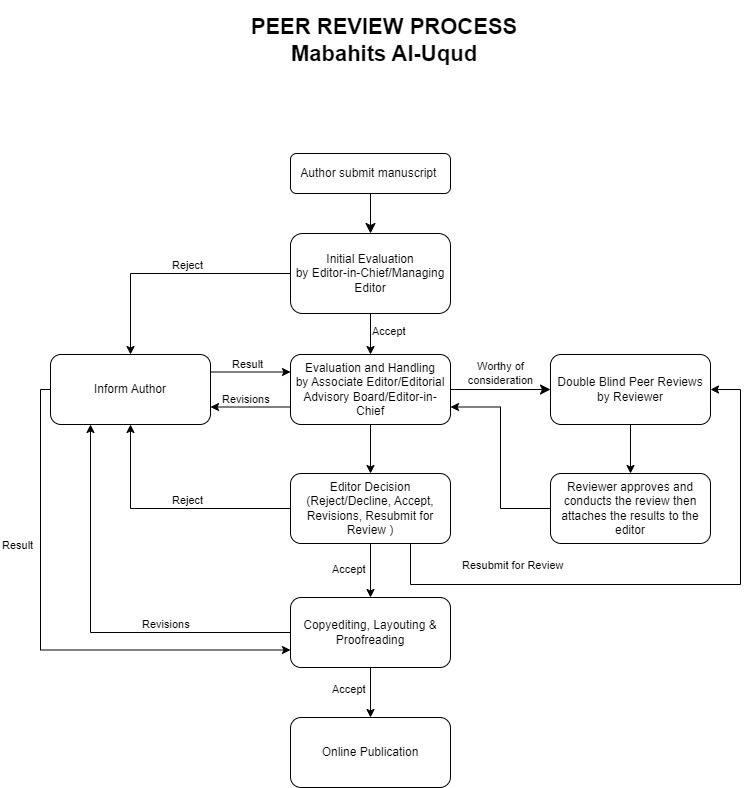Peer Review Process
MABAHITS AL-UQUD: REVIEW PROCESS
The peer review process is a vital part of our editorial workflow at Mabahits Al-Uqud. It helps the editor make well-informed decisions and provides authors with constructive feedback to improve the quality of their manuscripts. Here's how the review process works in our journal:

1. INITIAL EVALUATION
- The process begins with a preliminary review by the Editor-in-Chief or Managing Editor.
- During this phase, the editor ensures that the manuscript fits within the journal's focus and scope.
- A plagiarism check using Turnitin is also performed; if the similarity index is above 25%, the manuscript will be returned to the author for revision (For further details, refer to our Plagiarism Screening Policy).
- This stage also involves prioritizing manuscripts, such as those resulting from international research collaborations or other high-priority topics identified by the editorial board.
2. ASSIGNMENT TO ASSOCIATE EDITOR
- If the manuscript passes the initial evaluation, it is assigned to an associate editor or a member of the editorial advisory board for a more detailed review.
- The manuscript is assessed for its quality and relevance across various aspects.
- The assigned editor provides feedback, suggestions, and critiques to the author and makes an initial decision on the manuscript.
- While the editor can give extensive feedback, the Editor-in-Chief typically recommends up to three revisions (not including peer review-based revisions) before making a final decision.
- Manuscripts that clear this stage move on to a double-blind peer review.
3. DOUBLE-BLIND PEER REVIEW
- The editor then collaborates with one to three expert reviewers who assess the manuscript independently and anonymously.
- The reviewers focus on evaluating the manuscript's originality, methodology, and contribution.
- Based on the feedback received, the editor may request revisions from the author or reject the manuscript.
4. EDITORIAL DECISION
- After the peer review is completed, the editor decides whether to accept or reject the manuscript.
- This decision is based on the reviewers' comments, any revisions made by the author, and overall editorial considerations.
5. COPYEDITING
- The copyediting stage aims to refine the manuscript's structure, clarity, grammar, language, and formatting.
- This stage offers the last opportunity for authors to make significant changes to the content, as the subsequent stages focus primarily on minor corrections and formatting.
- The editor will suggest edits using Microsoft Word's Track Changes feature during initial copyediting.
- Once these edits are made, the manuscript is returned to the author for review and further revisions.
- The Copyeditor will then conduct a final review to prepare the manuscript for layout.
- An Associate Editor or Editorial Assistant typically handles the copyediting role.
6. LAYOUT AND FORMATTING
- In this stage, the editor and editorial assistant work closely with the author to format the manuscript according to the journal's layout guidelines.
- Once the layout is complete, the manuscript proceeds to the proofreading stage.
7. PROOFREADING
- The proofreading stage is intended to catch any remaining errors in spelling, grammar, or formatting in the final manuscript.
- Unless discussed with the Associate Editor, major changes are not allowed at this point.
- If any corrections are needed, authors should use the Proofreading Corrections box to specify errors and suggest changes.
- After proofreading, the manuscript is finalized for publication.
8. PUBLICATION AND OPEN ACCESS
- Once proofreading is complete and the final PDF is prepared, the manuscript will be published in Mabahits Al-Uqud.
- The manuscript will be available as Open Access, allowing free access to all readers.
Notes:
- This thorough peer review process is designed to uphold the quality, integrity, and transparency of our publication process.
- The Editorial Board strongly opposes any actions or pressures that might disrupt the peer review process or harm the journal, editors, reviewers, authors, or other related parties.
- Throughout the peer review process, editorial board members are supported by Editorial Assistants.
Loading...